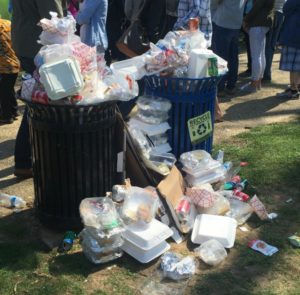
Overflowing trash cans can contribute to marine debris (Image via NOAA)
Volunteers remove more than 18 tons of trash from Great Lakes beaches each year. But…
“It’s not just stuff that’s left on the beach that is the problem,” says Anna McCartney of Pennsylvania Sea Grant. She says that during a two-year program, Erie Public School students learned that some marine debris starts out in their communities.
“We made watershed maps so that they could trace the storm water from their street, to the nearest storm drain, to the nearest stream, then to the lake,” she explains.
Then many students joined neighborhood trash clean-ups. So they learned first-hand that preventing litter in the lake means keeping trash off streets and sidewalks, too.
Hear Anna McCartney discuss the many ways the students participate in marine debris clean-ups:
Get Schooled:
- Read more about the project from Erie Times News.
- Check out what the students had to say about the effort.
The fine print:
- This segment was produced in partnership with Cornell University’s Atkinson Center for a Sustainable Future and made possible by the Foundation for Pennsylvania Watersheds.




